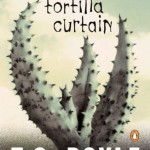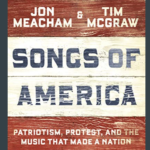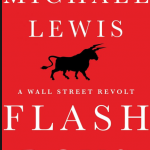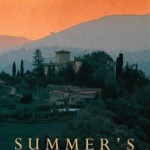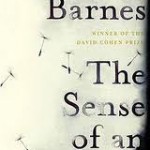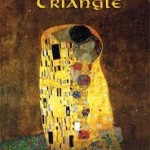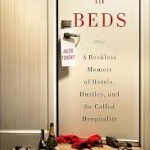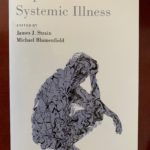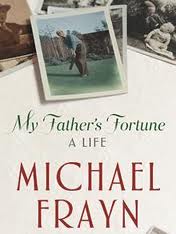Search results for ‘All THe Light We Cannot See’
All The Light We Cannot See by Anthony Doerr
February 25th, 2015 — 02:40 pm‘All the Light We Cannot See’ by Anthony Doerr. 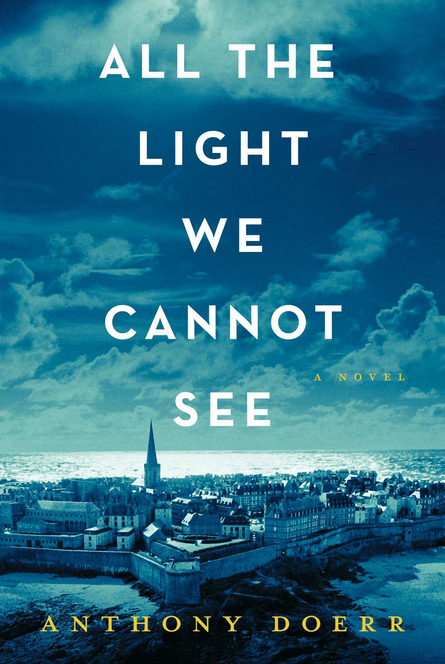
Why does a man who was born more than 30 years after the start of World War II decide to write about the lives of a young blind girl and a German youth during this period of time where their lives ultimately intersect?And why do I, who was born just before the start of this war, find myself still seeking out books about this period of time? This is a question I cannot answer, but I do have a recommendation for the readers of this blog, which I will share at the conclusion of this review.
Marie-Laure was born in Paris and became blind at the age of six. She was the daughter of a widowed locksmith of the Natural Museum of Paris. She was very close to her father, who when war broke out fled with her to the seaside town of Saint-Malo. They lived with her great-uncle who had been traumatized by World War I and was afraid to go out in the street. She was left living with him when her father did not return from a trip to Paris.The great-uncle had a radio in his attic, to which they could listen, as well as transmit. Werner Pfennig was a German orphan who grew up in a children’s home in Berlin. He developed a fascination with and the knowledge about radio circuits, which was the skill that ultimately became his work in the Nazi Army. There are many sub-themes in this developing story, which include the tale of a valuable blue diamond, which people believed gave special powers to those who possessed it. There also was a description of the ruthless training of the German youths and of the bravery of some of the French citizens that occurred during wartime.
Each chapter ultimately alternated between the lives of the blind French girl and the young German lad, as well as a few other people. It should not be surprising to learn that this book is very well-written and well-received. It received a National Book Award and was on the ‘New York Times’ bestseller list for 38 weeks. By examining the microcosm of these two persons’ lives the reader gets a feeling of the humanity, or the lack of it, of some of the people who lived and died during this horrendous recent history. As well-written as this book may be, it is really still a figment of the imagination of the talented Mr. Doerr. It is a fine piece of literature that could round out a reading list for the contemporary reader. However, if you are a young person wishing to be educated on this dark period of 20th Century history or even an older person who has not previously explored this era, this book may not be the place to start. I would suggest two other books; one a classic and the other one probably read by very few people. If you have not read it, I suggest that you read ‘The Diary of a Young Girl’ by Anne Frank, which is the memoir of a young girl in Holland during the Nazi occupation. This perhaps is the most well-known and well-received book about this period of time. The other book that I would suggest is ‘How We Survived – 52 Personal Stories by Child Survivors of the Holocaust’ (See my review of this book). This is a vivid, valid and authentic group of short vignettes that will hold your attention and tell a story as informative and moving as the fine novel which I just reviewed.There are also some other recent novels about the Holocaust that I would bring to your attention: ‘Once We Were Brothers’ by Ronald Balson, ‘My Sister’s Keeper’ by Jodi Picoult and ‘The Book Thief’ by Markus Zusak.( see my reviews of these books) This is obviously a topic that can be explored with many fine pieces of literature, and this book by Mr. Doerr is a very good addition to this library of books.
How We Survived-52 Personal Stories by Child Survivors of the Holocaust
January 6th, 2012 — 12:28 amHow We Survived- 52 Personal Stories by Child Survivors of the Holocaust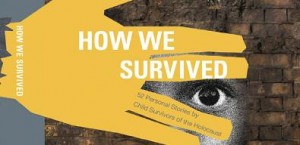
I have read many books about the holocaust, have seen many movies about this subject and have visited various holocaust museums throughout the world. As a psychiatrist, I have treated a few holocaust survivors and many more children of holocaust survivors.
I was therefore surprised how impacted I was by reading this book which consisted of the several page first person stories of 52 holocaust survivors most of whom were born between 1926 and 1938.
I became aware of this book it when a good friend of mine John Glass who is one of the 52 authors, showed me a copy of the book and told me about the project behind it. Each author is a member of the Child Survivors of the Holocaust, Los Angeles Organization that was founded in 1983 after the publication of the book “ Love Despite Hate” by Sarah Moskovitz, PhD which consisted of interviews with child survivors of the Holocaust as adults. Dr. Moskolovitz and Dr. Florabel Kinsler organized the largest international group of child survivors with a membership of more than five hundred people. In the introduction to this book, Marie Kaufman President of the Los Angeles child survivors group and Chair of the Editorial Committee that put together the book noted that many of the authors have given oral testimony to museums and to the Shoah Visual history Foundation. But in the fifteen to twenty years since they have done so, they have become aware that for many reasons they have left part of their story untold. This book gave them opportunity to disclose secrets never divulged before.
As one reads this book and digest the narrative which is recounting horrific early childhood memories, you cannot help but consider whether these are true memories. Could they be screen memories, retrospective memories based on things they were told and learned at a later age? In the course of psychotherapy and psychoanalysis we often help patients reconstruct early childhood memories and feelings. The accuracy of the actual memory may not be as important as the meaning. I do believe that the memories reported in this book do ring to be quite true. I also would suggest a simple exercise before you read this book. Reflect back on your three or four earliest memories. Sometimes it will be helpful to choose a key event which you can easily date such as the birth of a sibling, a death or tragedy or famous event such as the assassination of JFK or Martin Luther King or the landing on the moon, a particular grade school teacher etc. Often the event that you recall will have some negative or conflictual quality. My own earliest memory is when my mother left me alone in our apartment for a few minutes to do an errand and brought me back a chocolate bar. When I discussed this memory with her many years later, she was astounded that I exactly recalled the events and she was able to date it when I was less that three years old. I recalled being under the care of an aunt during the time that my sister was born and my disappointment that a cousin has seen her first. I was less than 5 years old . I also recalled my first day of kindergarden , when I was a few months older than 5. While each of these memories had some anxiety and conflict, they were minuscule compared to the intensity of experiences of being taken away from one’s parents, hiding for prolonged periods of time, starving and witnessing and being threatened with death and destruction all of which were common place in the 53 stories of this book.
There is another important dynamic which inhibited many of the child survivors from publicly telling their story . Many were hidden children who often had to assume non Jewish identities, sometimes having several different gentile names and personas over time as young children during the war . Each time it was impressed upon them that under no circumstances were they to reveal their Jewish identity as this could mean death to them and their adopted families. So even after they were liberated, reunited with any surviving families and were beginning new lives in the United States, many still would not readily talk about their Jewish identity especially with strangers
It is very difficult to understand the experience that these children had where a normal childhood was transformed almost overnight when Kristalnacht occurred in Germany, or when the Germans took over in Poland and issued the new regulations for Jews or similar events that happened in France, Hungry, Italy, Holland and any other places conquered by the Nazi’s. They moved from their comfortable apartments or homes to the Ghetto where they were jammed into one room with extended families and strangers. In anticipation of this situation or in response to it many of their parents made a decision where it was possible to do so, to send their children into hiding with non-Jewish families. In most of the cases the parents could not be hidden with their children. Childhood separation from parents is a very meaningful experience, usually traumatic with the possibility of lasting yearning, resentment, with a wide range of fantasies. This becomes colored by the subsequent events which might include loving, rejecting the adoptive parental figures as well as being torn away from one such family as you are moved to another one. . The fate of their Jewish parents was often death as was that of most of the their original families and friends. While many of the child survivors intellectually came to understand that the decision to try to hide them allowed them to live, the full emotional understanding of this generous act on the part of their parents did not come to them until many years later. It was often when their own children born in a safe environment were now the age at which they had been put into hiding by their own parents, did they appreciate the sacrifice that was made for them. For some this realization did not occur until they had grandchildren who are at the age that they were hidden .
It is important to note that the trials and tribulations for many of these child survivors did not cease with their liberation from concentration camps or from their places of hiding.
In some situations there was persecution by the Russians who liberated them or continued anti-Semetism when they tried to return to their home town. There were hard times often relieved by the many organizations and people who tried to help them reunite their families. There were painful discoveries of what happened to missing family members. There was also long waits for visas to new countries , long travels across the ocean, learning new languages and adapting to a new culture
As was the case of many survivors who were adults during the holocaust , these child survivors spent many years trying to forget and not to look back. They were building a new a life and did not want their children haunted by such terrible events. Their parents who survived or adoptive parents and relatives often did not believe that the experiences which they had as children made a lasting impression on them. As they moved on to a “normal life” in the United States the child survivors themselves thought that their memories and experiences were quite unique and as mentioned above were not inclined to talk about them. Many report an amazingly dramatic unburdening feeling when they attended their first meeting of child survivors. The intensity of that feeling and the realization that so many other children had gone through similar events was life affirming and literally changed the course of the lives.
It is noteworthy that so many of the child survivors have gone on to have very productive lives. Perhaps because they themselves have been helped by strangers (many of whom have been recognized in Yad Vashem as the ‘righteous gentiles” or “righteous among nations”) they have chosen a helping profession themselves. It seems to me that a high percentage have gone on to be social workers, therapists and teachers. Some report moving into these fields after a successful career in business. Others have become artists and poets expressing their feelings and experiences in their work. There were numerous poems as part of the narratives.
Many of the child survivors did not talk about the past for most of their lives and for many it has only been in their twilight years that most have felt an obligation to tell their stories or record a first hand account that will exist for future generations. A good number of the authors of this have devoted many hours to teaching about the holocaust in schools and museum and giving lectures in various settings. These activities and the writing of the chapter for this book as well as other publications that some of them have done appears to have been therapeutic for the. .
The authors appeared to have tried their best to be sincere and honest in sharing all these events and their past and present feelings about what they have been through. For most there is a triumph for having survived and for being responsible for the presence of so many wonderful people that they have nurtured and supported in their subsequent lives For some of people there is still an ever present wound or bewilderment and pain which stretches from their childhood to their later years. They are still trying to figure out why and how the events of their childhood could have happened. For all there is the satisfaction of having told the story of what really happened so those who were deprived of their lives will not be forgotten
This was not an easy book to read. While I read it in linear fashion over a two week period and did not intersperse with other books perhaps that might not be the best way to read it. For some it might be best to consume it in small doses . I suspect that some readers will appreciate the value of the book but will put it aside and may not complete it.

I realize also that I may not have captured the essence of the experience of the authors in this review. I would like to give you a few random excerpts although I hope over time you will read the complete version of each of these 52 stories as they all deserve to be remembered:
Lea- Born 1938 I was placed through the Dutch underground with a Christian family. There were many other children. Suddenly the family was betrayed. The underground took all the children away to new hiding places. On of my first memories was of being on a train with other boys and girls…. I was taken to family of farmers in the small town of Horst by two men dressed in police uniforms. My clothes were torn and I had sores all over my body. The men said that they ha d smuggled me out of some detention center but I have never been able to find out what happened to me.
Jack- Born 1926- The ghetto was organized into factories of every possible trade and all the the production was for the German military…My father could not get employment…When I saw my dad for the last time he was forty one years old…In July 1944 we were transported in cattle cars to Auschwitz-Birkenau. I was with my mother…(We) went through a selection conducted by Dr. Mengele. My mother was sent to the other side. Now sixty four years later, I can still see her walking hunched over, as if she know where she was going. I’m still haunted by this picute and I know that I will for the rest of my life. How do I reconcile the fact that my children are now older than my parents were when they were murdered.?
Lya- Born 1936- When I was seven and she (sister) was four we both went into hiding with different families. The thought never occurred to me that this would be the last time I’d ever see my parents. They never knew where we ended up…In 1946 my sister and I were sent live with Parents Number 5 in Denmark…I was a very difficult teenager. Obstinate, opinionated, aggressive. I was sent out of class many times. It was sheer anger- a way of expressing myself to the world…My husband ( also a survivor) wasn’t interested in talking about his experiences and for the longest time I didn’t think that mine really countered. …I started dealing with my past in 1993, I was fifty six…. That’s when I first shared my story ( in a group ) about losing my parents, grandparents, being separated from my sister and being in hiding with strangers. After that night, I became more aware of my own feelings. I could justify them. They were real and they weren’t something nonexistent.
Peter- Born 1936- In 1940 when I was four years old I was no longer permitted to attend my pre school nor to attend any other school. From my earliest memories, I had to wear a yellow star with the word “Jude” on my jackets and shirts…People looked at us in disgust and were often rude to my mother when she shopped for food…Only 32 out of the 100 Jews transported in the cattle car I was in survived the Holocaust. I lived in the children’s barracks (in Terezin)…We slept in bunk beds on straw and had only a thin blanket. There was only cold water to wash ourselves in the summer and harsh winters…There was small piece of bread in the morning with some brown water they called “coffee” and for supper a watery soup with an occasional small potato. We were half starved yet we were expected to work…(After the war)I lived my teenage years as a laborer, farm hand truck driver across the US. …By the age of 33 I had completed high school, graduated from San Diego State University and received a graduate degree in Global Management. … I have seven grandchildren.
Robert- Born 1935- When I was four years old our lives changed forever, The Gestapo came to our apartment and told us to take just a little luggage and follow them. They sent us by train to the Polish border. The poles would not let us in and Germans would not take us back…We traveled around Poland living as gentiles with an assumed name….The family that hid me decided to put me in the attic in the house. Many times they forgot to take care of me and did not feed me. …After the uprising failed the Germans planned eliminate the city’s population.. Everyone was loaded upon trains, which were headed to Auschwitz. …We knew we were going to be killed…My mother noticed that one of the cars had an opening on top. The train stopped about 100 yards from the Auschwitz concentration camp. My step father Emil lifted me up over the open car and I was able to open the train car door…In February 1947 we took a boat to America and settled with our extended family in Pittsburgh. I quickly learned English and graduated from Carnegie Mellon University in 1957 with degree in electrical engineering. …Over the years I have spoken about the holocaust to thousands of middle and high school children.
Erika- Born 1928- At the time of my birth my parents (in Hungary) owned two kosher restaurants. I went to school unitl the age of fourteen when the anti Jewish Hungarian government closed the Jewish schools. Anti-Semetism forced many Jewish owned businesses to close or be taken over by non-Jews. Most of my uncles had been taken to forced labor camps in early 1940-42…I was deported to Auschwitz with my mother. We were lucky and escaped the selection. …On the day the Soviet liberators entered our camp they raped many women and wanted us to work for them. …I was helped tremendously by breaking the silence and talking about my experiences. Confronting my losses and acknowledging the effects of the traumatic times in my life have helped me to recover psychologically. However I still have problems such as fear of authority, anxiety about the health of my family, about separation and the fear of loss.
For more information or to order this book go to www.childsurvivorsla.org
The Book of Lost Names by Kristin Harmel
March 9th, 2021 — 11:16 pmThe Book of Lost Names by Kristin Harmel
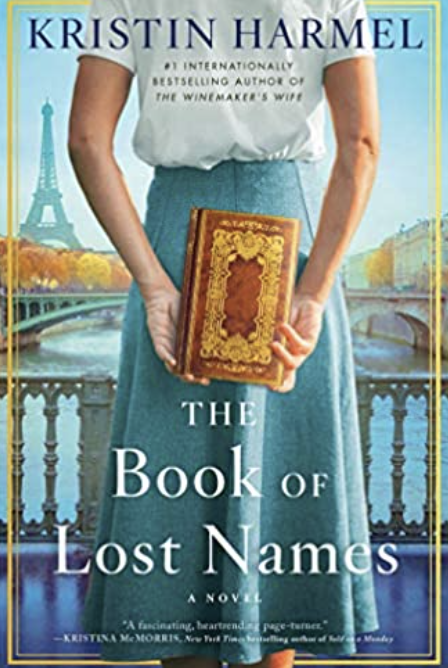 When I came across this outstanding book about the Holocaust, I was immediately reminded of all the excellent and meaningful books I have read about this subject. The first one probably being The Diary of Anne Frank and then so many other such interesting reads such as The Thief, The Nightingale, All the Light We Cannot See, Schindler’s List, as well as many others including many that I have not yet read.
When I came across this outstanding book about the Holocaust, I was immediately reminded of all the excellent and meaningful books I have read about this subject. The first one probably being The Diary of Anne Frank and then so many other such interesting reads such as The Thief, The Nightingale, All the Light We Cannot See, Schindler’s List, as well as many others including many that I have not yet read.
This story is about a woman who has skills, which make her an excellent forger, which allows her to save the lives of many children and adults as they escape from the Nazis. In doing so, she puts her own life at great risk. This triggers a familiar question, “Could I have put my own life at such a great risk if faced with a similar situation.” Most of us will never know, but as we experience the bravery of this woman, we are challenged to consider this question.
The story highlights the complexities of the parent-child relationship in this difficult situation. Factor in a love and romance and the conflicts of such feelings when the woman has these feelings towards a non-Jewish man that she never imagined could take place.
The great value of this book is not only that it is a well written adventure story with romance, intrigue, and danger, most important, it reminds us that Nazi Germany existed in the lifetime of some of us or in the lifespan of our parents and cannot be allowed to be forgotten.
Comment » | FH - Fiction Historical, FT- Fiction Thriller, HI - History
From sand and Ash by Amy Harmon
January 6th, 2018 — 12:37 am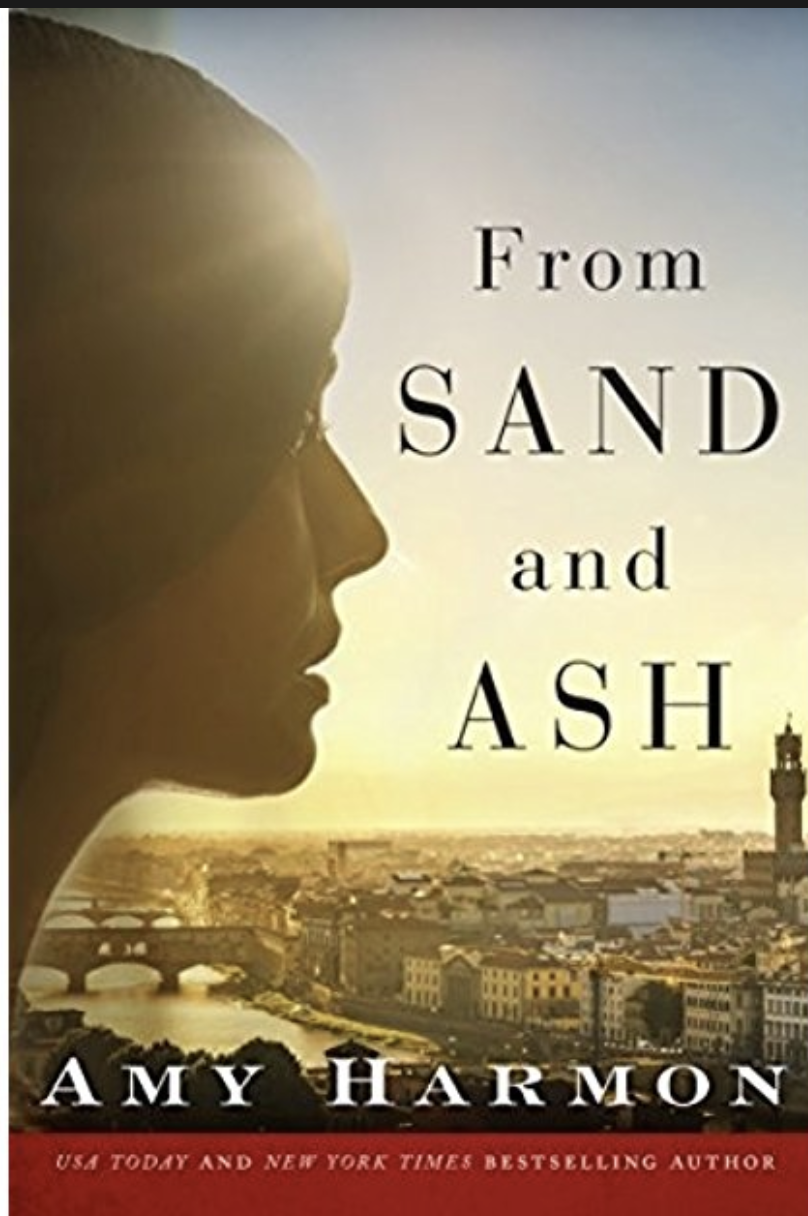 From Sand and Ash by Amy Harmon
From Sand and Ash by Amy Harmon
If I had to make a list of the books that made the greatest impression upon me, I’m pretty sure I would include the Diary of Anne Frank, Schindler’s List and Sophie’s Choice. Not surprising these books all deal with the Holocaust. Growing up in the post World War II, I became acutely aware of the details of what was done to the Jewish people in Europe in the previous decade. My own relatives who are not “survivors” but had family in Europe who perished during that period of time rarely talked about the details which probably fueled my interest. Being Jewish, I felt a personal connection to understand this horrific period of history. As a young psychiatrist working in Brooklyn, I treated a number of children of concentration camp survivors which made a lasting impression on me.
In the past few years, several excellent books which delved into this subject have been reviewed in this blog. This includes How we Survived, The Nightingale, All the Light We Cannot See, Once We Were Brothers, Maus I&II and The Book Thief.(you can click these titles to see my review of each of them )
This current novel From Sand and Ash by Amy Harmon examines the impact of the Holocaust in Italy. In particular, it puts a light on the heroic efforts of members of the Catholic clergy who secretly risked their lives to save many Jews who had become the target of the fascist government of Mussolini which was was allied with Hitler.
The main characters are a Catholic priest and a Jewish young woman who grew up together since childhood. The author in the postscript revealed that these characters were fictional but all the horrible events depicted were real and based on factual events. The author appeared to pay close attention to historical details at the same time that she wrote a beautiful love story. As I finally closed the book after completing it I asked myself three familiar questions: How could so many people do such terrible things to the Jews? How did some people develop the courage to risk their lives and the lives of their families to try to hide and save so many Jews. What would I have done if I had faced the challenges of that time period?
This is a well-written book that may not answer these questions but will provide a page turning experience, which will hold your interest and attention as well as connecting to your emotions.
To purchase this book from Amazon, please click here
Comment » | FH - Fiction Historical, FR - Fiction Romance, Uncategorized
11/22/63 by Stephen King
July 14th, 2016 — 11:18 pm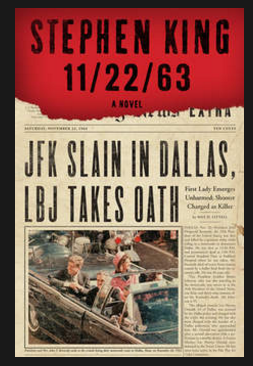 11/22/1963
11/22/1963
By Stephen King
The main character of this novel is Jake Epping, a school teacher in Maine, who is introduced to a “rabbit hole” in time. That is, if he steps through an opening in a pantry and finds an invisible but palpable small staircase, he will come out on the other side on a particular day in 1958. No matter how long he stays at this new time when he steps back to his original time, it will be that he has only been gone for two minutes. He is introduced to this unusual situation by Al, an acquaintance who is an older man dying of cancer who has made several excursions back to 1958 and lived there for a while. As indicated in the title of this book, “11/22/63” is an important date in this story. As any American knows this was the date that President John F. Kennedy was shot and killed by Lee Harvey Oswald. Old dying Al was planning to stop the assassination of JFK and now hopes that Jake will take on this task and he provides him with some preliminary observations on Oswald that Al has made during his several visits back in time.
As you can imagine this can be a complicated process. How would this presidential assassin be stopped? What about the lingering question whether Oswald acted alone? Also, if you are going back in time even for such a worthy cause might you also try to change the course of some other events perhaps prevent an innocent child being murdered or scarred for life? But most important, what are the implications of traveling back in time and altering history?
Who better to take on these questions than Stephen King, one of the most successful, prolific contemporary authors of horror, supernatural fiction, suspense, fantasy and science fiction? This novel published in 2011 was approximately King’s 52nd novel which doesn’t include his very numerous other writing endeavors such as novellas, short stories, movies, television programs and many other projects dating back to 1974 when his first novel Carrie was published. King has established himself as one of the creative writing geniuses of modern times. Not only is he original and very imaginative but he builds these ideas within insightful character development. King also does extensive research on all aspects of his subject matter. In this case, as discussed by the author in the epilogue to the book, which included interviews with him, he has read extensively about the history of JFK and his untimely death. This included numerous books written about all the circumstances, details and cast of characters of the events that occurred on 11/22/63. He also spent time visiting and studying Dallas and The Book Depository where Oswald was perched to shoot Kennedy as well as other places mentioned in the book.
Perhaps the most stimulating aspect of this book to me is the intriguing so called “butterfly question”. If one could travel back in time and change anything, how would that alter future events which would impact on other subsequent events? Would the slightest flutter or minute change in the course of history cause other changes which might cascade to unexpected major events? Would seemingly insignificant changes lead to more meaningful changes? Even if one could alter the course of history, can we be sure it would ultimately be for the better?
As Jake, the main character of this book, immerses himself into the past, readers cannot help but be on the edge of their reading seats whether we are flipping pages or pushing buttons. We find ourselves wondering what would we do and how would we do it if we found ourselves being able to go through that rabbit hole in time? There were surprises, moments of elation and disappointments. I could not wait to find how the story would end and I was sorry when it was over.
To obtain a copy of this book or another book by Stephen King, please click here
Comment » | FH - Fiction Historical, FSF - Fiction Science Fiction
My Father’s Fortune by Michael Frayn
April 21st, 2012 — 11:13 pmMy Father’s Fortune—Michael Frayn is an accomplished author and playwright who has written the story of his father’s life which is in part an autobiography of his own youth growing up in the outskirts of London. The author has already exceeded the life span of his father who died at the age of 69. The book is Frayn’s attempt of a remembrance of his father, which he wishes to pass on to future generations of his family. By his own words, his father was not a remarkable man, rather quite typical for the times. His son is able to put this story in public view because he is an accomplished writer who writes quite well and has a history of successful award winning novels and plays. It is not because it is a captivating unique, particularly insightful view into the human psyche. As a psychiatrist who has had the privilege of listening to many family histories in great detail over the years, this one as presented doesn’t not rate very high as one with complex or unusual revealing psycho dynamics. Of course it was not the purpose of this author to purport his story as anything more than the tale of his beloved father.
Certainly since the author’s mother died when he was a pre-adolescent, his father took on a more significant role in his life . This was especially pertinent because his subsequent stepmother never became very important to him or to his sister. His father was a poorly educated man who had a difficult childhood, had a hereditary hearing deficit (which was not passed on to his sister or himself) and worked as an asbestos salesman for most of his life. He never had much money and would always prefer to buy something second hand or improvise even when he could afford things. He wasn’t particularly affectionate to his kids and actually made his son feel that he was a disappointment to him because he never quite caught on to the British national sport of cricket. In retrospect, the author appreciated his father’s effort to see that he had a good education which made a difference in his life especially because he became a man of words.
It should be mentioned that the picture which he painted of his only younger sibling was not very flattering. He noted that she chose not to talk to him or his second wife for most of his adult life, without any reason known to the author. In the end, the book as broadens the reader’s cultural awareness, by describing a close up look at one family in London, in the generation spanning before, during and after World War II. The family highlight was the family’s experience with the “doodle bomb” which was the Nazi’s pilot less rocket bombs which frequently attacked their neighborhood and all of London.
We cannot fault this talented author for wanting to tell the story of his family for future generations of his progeny. However, it would have been twice as good a read had the author instead written a novel and weaved a plot or an interesting storyline on top of all the descriptions of the events of his family.

